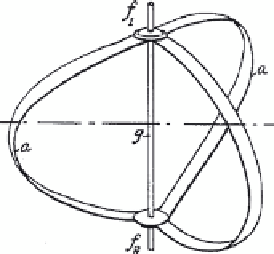Environmental Engineering Reference
In-Depth Information
(a)
(b)
Figure 5: Images from the Darrieus VAWT patent [10 ]: (a) curved-blade rotor
embodiment; (b) plan view of straight-blade rotor showing an optional
active blade pitching mechanism.
of the wind on each blade throughout its travel around the rotor circumference (as
shown in Fig. 5b). However, it was not until the energy crisis of the early 1970s
that Darrieus' rotor was developed to the point whereby it became a commercially
viable wind turbine.
The Darrieus turbine can take a number of forms but is most well known in the
geometry sometimes called the “egg-beater” shown in Fig. 5a, where the two or
three blades are curved so as to minimise the bending moments due to centrifugal
forces acting on the blade. The shape of the curved blade is close to that taken by
a skipping rope in the absence of gravity and is known as the Troposkein (“spin-
ning rope”). The Sandia National Laboratory wind research team was one of the
leading groups in development and analysis of the Darrieus curved-blade turbine.
One of the fi rst devices tested was the 2-m diameter Sandia research turbine, which
was tested in a 4.6 m
6.1 m wind tunnel and later fi eld-tested at the Sandia
National Laboratories wind turbine site [11]. The match between the wind tunnel
and fi eld tests was very close and this study indicated that a maximum power coef-
fi cient for this machine of
C
p
,
max
×
≈
0.32 was achievable, which was promising for
a relatively small device.
A second 5-m diameter demonstration turbine was then developed, also with a
curved-blade rotor. This was superseded in 1975 by the 17-m diameter Sandia
Demonstration Darrieus turbine which ran successfully over several years and pro-
vided important experimental information on the aerodynamics and structural
dynamics of the Darrieus device. In 1988, a much larger 34-m diameter machine,
known at the 34-meter Test Bed, was commissioned at Bushland, Texas. This
device with aluminium blades had a rated power output of 0.5 MW and it provided
a wealth of data on the fi eld performance of a large VAWT [12]. Indeed the Sandia
National Laboratories website [13] remains, at the time of writing, a rich source of
information on many aspects of Darrieus turbines, including analysis, design and
performance.


Search WWH ::

Custom Search